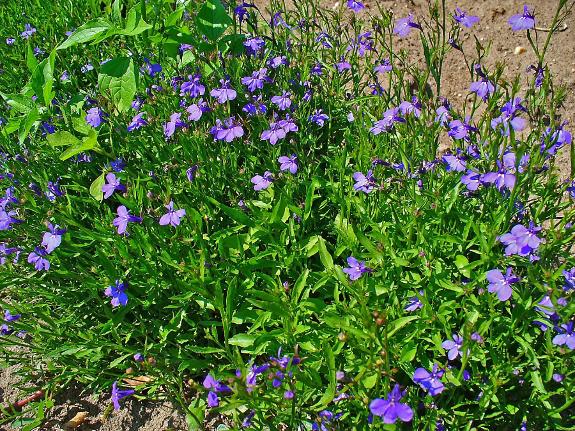

Sections
Highlight

Denise Bush
Friday, 27 April 2018, 11:02
Compartir
Lobelia erinus is commonly called Edging lobelia and is probably the most well known of the genus, being a firm favourite for use in hanging baskets and borders. Both upright and trailing varieties are available in a range of colours including intense blue, purple, pink, white and pale blue, often with a white or yellow 'eye'. Butterflies and bees love them.
It is not hardy and best grown as an annual although in mild winters it may survive and produce new shoots in the spring. The blooms appear from late spring and through the summer until it gets really hot and then lobelia will shut down and become dormant, sometimes flowering again in the autumn as the temperatures drop. It needs a rich, well-drained soil and will grow in full sun although partial shade is better. Allowing Lobelia some shade will result in more luxuriant foliage and deeper coloured flowers. The upright lobelia will form a mound 20cm high by about 30cm wide.
The small, narrow leaves are serrated and are often tinged bronze, especially on the plants with darker blooms. During the summer the leaf colour on its own adds interest even if flowering has stopped. A light trim after flowering will encourage more blooms in the autumn.
Although Lobelia erinus can be grown from seed, they are usually available in cell packs from garden centres, ready to plant out. The trailing varieties can be planted in pots so that they cascade over the sides while the upright varieties are best for edging. They are not drought resistant and will need regular watering during the hottest months.
The genus Lobelia was named after a sixteenth century Flemish botanist called Mathias L'Obel.
Maria Hillen sent in this photo of a Salvia officinalis, commonly known as sage. She says she was given it as a little cutting a few months ago and it has shot up with all the rain. Salvia is a member of the mint family (Lamiaceae) and native to the Mediterranean region. Not only is it a useful culinary herb it also has spectacular flowers and earns its place in the border or on the patio on ornamental merit alone. It is also a bee magnet.
Hanging baskets look fabulous in the summer but they need special preparation and after care to keep them that way. The first rule is to use good quality compost. It should contain sufficient fertiliser and trace elements to last several months but it doesn't hurt to mix in some slow release fertiliser to extend its life. At the same time a few handfuls of water-retaining crystals will be of benefit. Use a liner, either plastic or a made-to-measure felt liner from the garden centre as traditional moss is unlikely to survive the summer heat. Next step is to choose the plants. A rule of thumb is one plant per inch of basket so a twelve inch (30cm) diameter basket will need twelve plants. Plants suitable include begonia, impatiens, fuchsia, pelargoniums, carnations, lobelia and petunias. Or be creative and use culinary herbs or low growing succulents. Try to avoid hanging the basket in full sun and preferably shelter it from drying winds. Water regularly and if the basket starts to dry out get a big bowl or bucket and submerge the whole basket for a couple of hours.
Publicidad
Publicidad
Publicidad
Publicidad
Reporta un error en esta noticia
Necesitas ser suscriptor para poder votar.